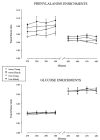The response of muscle protein anabolism to combined hyperaminoacidemia and glucose-induced hyperinsulinemia is impaired in the elderly
- PMID: 11134097
- PMCID: PMC3192447
- DOI: 10.1210/jcem.85.12.7021
The response of muscle protein anabolism to combined hyperaminoacidemia and glucose-induced hyperinsulinemia is impaired in the elderly
Abstract
Muscle mass declines with aging. Amino acids alone stimulate muscle protein synthesis in the elderly. However, mixed nutritional supplementation failed to improve muscle mass. We hypothesized that the failure of nutritional supplements is due to altered responsiveness of muscle protein anabolism to increased amino acid availability associated with endogenous hyperinsulinemia. We measured muscle protein synthesis and breakdown, and amino acid transport in healthy young (30 +/- 3 yr) and elderly (72 +/- 1 yr) volunteers in the basal postabsorptive state and during the administration of an amino acid-glucose mixture, using L-[ring-(2)H(5)]phenylalanine infusion, femoral artery and vein catheterization, and muscle biopsies. Basal muscle amino acid turnover was similar in young and elderly subjects. The mixture increased phenylalanine leg delivery and transport into the muscle in both groups. Phenylalanine net balance increased in both groups (young, -27 +/- 8 to 64 +/- 17; elderly, -16 +/- 4 to 29 +/- 7 nmol/(min.100 mL); P: < 0.0001, basal vs. mixture), but the increase was significantly blunted in the elderly (P: = 0.030 vs. young). Muscle protein synthesis increased in the young, but remained unchanged in the elderly [young, 61 +/- 17 to 133 +/- 30 (P: = 0. 005); elderly, 62 +/- 9 to 70 +/- 14 nmol/(min.100 mL) (P: = NS)]. In both groups, protein breakdown decreased (P: = 0.012) and leg glucose uptake increased (P: = 0.0258) with the mixture. We conclude that the response of muscle protein anabolism to hyperaminoacidemia with endogenous hyperinsulinemia is impaired in healthy elderly due to the unresponsiveness of protein synthesis.
Figures




References
-
- Evans WJ. What is sarcopenia? J Gerontol A Biol Sci Med Sci. 1995;50:5–8. - PubMed
-
- Lexell J. Human aging, muscle mass, and fiber type composition. J Gerontol. 1995;50:11–16. - PubMed
-
- Wolfson L, Judge J, Whipple R, King M. Strength is a major factor in balance, gait, and the occurrence of falls. J Gerontol A Biol Sci Med Sci. 1995;50:64–67. - PubMed
-
- Tinetti ME, Williams CS. Falls, injuries due to falls, and the risk of admission to a nursing home. N Engl J Med. 1997;337:1279–1284. - PubMed
-
- Roberts SB. Effects of aging on energy requirements and the control of food intake in men. J Gerontol A Biol Sci Med Sci. 1995;50:101–106. - PubMed
Publication types
MeSH terms
Substances
Grants and funding
LinkOut - more resources
Full Text Sources
Other Literature Sources
Medical
Miscellaneous

